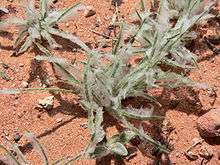Dasyochloa
| Dasyochloa pulchella | |
|---|---|
 | |
| Scientific classification | |
| Kingdom: | Plantae |
| (unranked): | Angiosperms |
| (unranked): | Monocots |
| (unranked): | Commelinids |
| Order: | Poales |
| Family: | Poaceae |
| Subfamily: | Chloridoideae |
| Genus: | Dasyochloa Willd. ex Rydb. |
| Species: | D. pulchella |
| Binomial name | |
| Dasyochloa pulchella (Kunth) Willd. ex Rydb. | |
| Synonyms | |
|
Erioneuron pulchellum | |
Dasyochloa is a monotypic genus containing the single species Dasyochloa pulchella[1] (formerly Erioneuron pulchellum),[2] known as desert fluff-grass or low woollygrass, a densely tufted perennial grass found in the deserts of the southwestern United States.[3]
Range and habitat
It is native to the Southwestern United States, California, and northern to central Mexico, where it grows in dry regions such as deserts.
Growth pattern
It is a perennial bunchgrass forming small tufts just a few centimeters high with clumps of short, sharp-pointed leaves. The tufts are often enveloped in masses of cottony fibers; these are actually hairlike strands of excreted and evaporated mineral salts.[1]
Stems and leaves
The leaves produce soft, cob-webby hairs that dissolve in water, after summer rains.[3] The hairs are typically not present in spring.[3] Numerous hairless, wiry, stems are 2–5 inches (5–13 cm) tall.[3]
Inflorescence
The hairy inflorescence is a spikelet on the end of the stem, surrounded by a bundle of bractlike leaves, and is 1/4" to 1/2" long.[3] The spikelets which are pale in color, sometimes striped with red, purple, or green. It blooms from February to May.[3]